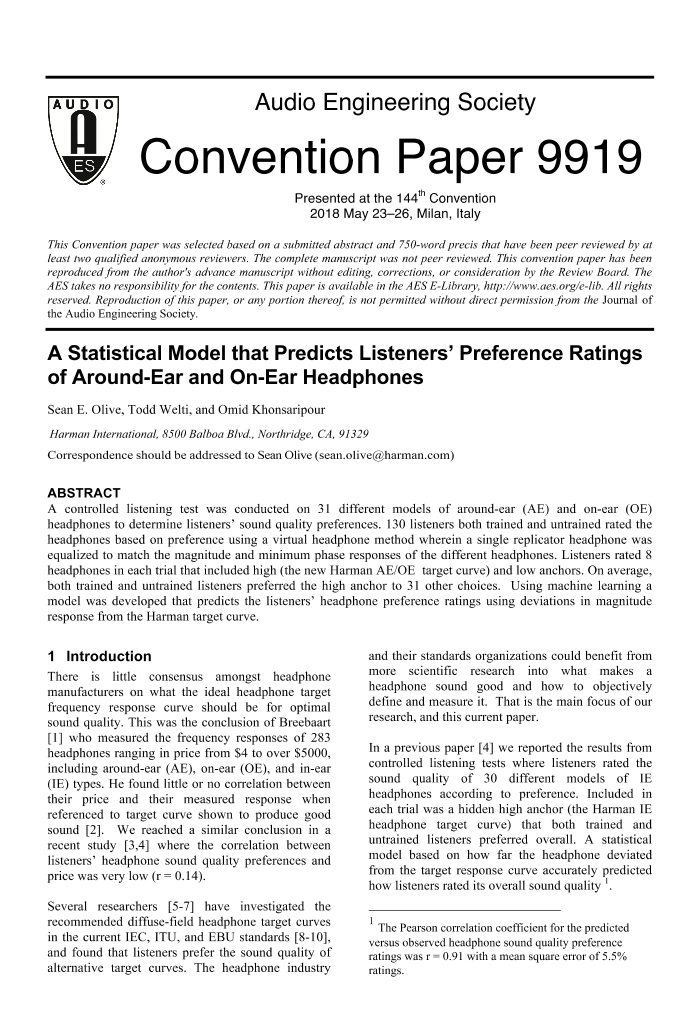Not quite ! But Perhaps I didn’t make myself understood well enough, sorry for that. That only coupling insensitive headphones should be used for listening tests is a given and a good practice that Harman and others already used.
What I meant is that for these headphones, we know that at least up to 4-5kHz, the on-head, in situ response on the cohort of listeners that participated in listening tests translates pretty well from ear simulators, and that they show good consistency across individuals. Preferences for this or that curve, or adjustments to bass and treble levels were made using these headphones. As a result, given the current lack of listening tests for newer 5128 targets, I believe that it is prudent that preliminary targets produce an error curve close to the one these headphones produce on 711 test rigs compatible with the Harman target, at least up to a few kHz. Otherwise it would logically mean, without any evidence born out of listening tests, that these listeners would have changed preferences in the meantime.
Here’s an illustration of that using three 5128 targets :
- One born out of
Harman’s participation to the HBK conference.
- The LMG 0.6 target
- Headphones.com’s 8dB tilt target
I’d like to point out again that all three companies consider these targets preliminary and a work in progress.
And data obtained scrapping the curves from the HBK conference, which has the convenience of using the same samples and Harman’s own modded 45CA, and the inconvenience of being fairly low res.
Here's the 5128 preliminary targets :
View attachment 282533
This is the error curve of the HD800, HD650 and Utopia, measured on Harman’s modded 45CA, vs the Harman target :
View attachment 282535
Now this is a comparison of these error curves vs. the three preliminary targets mentioned above :
View attachment 282536View attachment 282537View attachment 282538
It should be quite clear that LMG’s target, in spite of being based on DF HRTF, is the closest of the lot overall, and particularly below 1kHz. Which not that surprising, given how it came out to be, as it’s a fairly direct use of Harman’s empirical data in terms of preferential adjustments to the baseline, as unsatisfying as it might be theory-wise. Harman’s own preliminary target misses the mark below 1kHz essentially because they included in the transfer curve a good chunk of headphones that are highly sensitive to coupling issues, which is a fairly obvious methodological issue. It does perform better than the others past 1kHz (which is to be expected given the method used), but this is also where HPTF variation, either inter-individual or inter-HATS, may start to occur, even for large, open over-ears... I'm a bit on the fence here on which approach should be preferred, but as long as targets using other methodologies, such as using DF HRTF as their baseline, don't show an excessive difference in terms of error curve, as a preliminary work it could be OK.
Now if we look at the K550 on the other hand, we see that the LMG target is the worst in terms of matching the 711 Harman target’s error curve :
View attachment 282541
But that is totally and utterly fine, as the K550
are very sensitive to coupling issues. That the LMG target doesn’t match the 711 error curve is not necessarily indicative of an issue with the 5128 HATS or the LMG target, but in all likelihood indicative of an engineering or design defect on behalf of the K550 (headphones shouldn't be sensitive to coupling issues, it's just bad design and engineering as it makes any attempt at delivering any target futile).
Ulterior listening tests, whether using 711 or 5128 HATS for that matter, could very well prove that an alternative curve, that’s a bit different here and there from the Harman target, is preferred over it, but for now it’s just to me prudent that for these coupling insensitive headphones, the error curve remains similar to what is found on 711 HATS when using the Harman target, and absolutely fine if it isn't the case for headphones sensitive to coupling issues.



